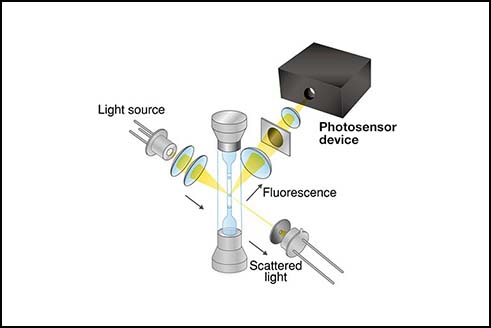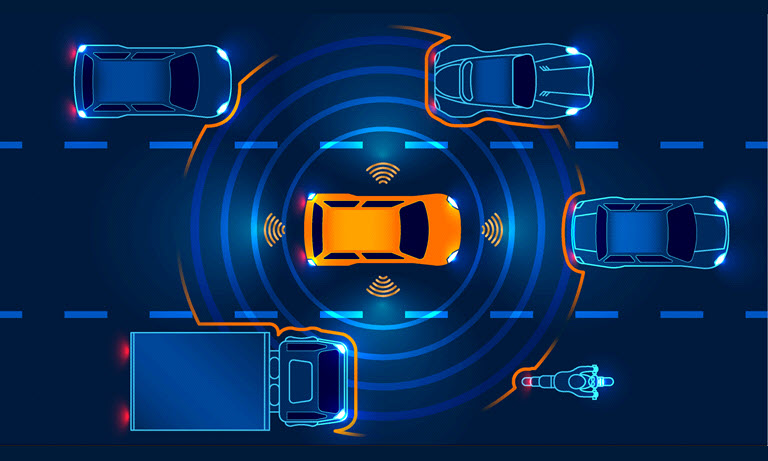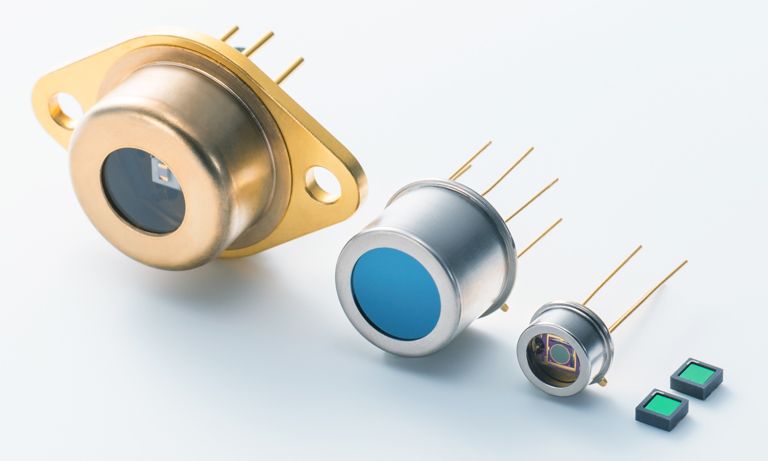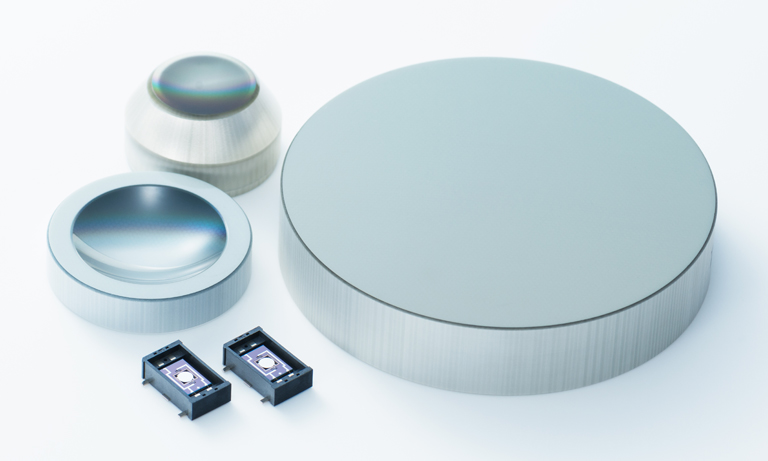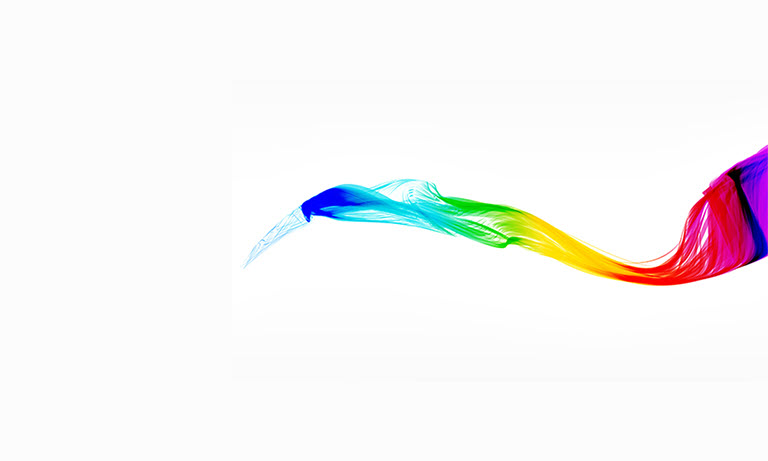Application notes
Technical notes
Ask an engineer
Publications
United States (EN)
Select your region or country.
TDI imaging: An efficient AOI and AXI tool
Yakov Bulayev, Hamamatsu Corporation
March 2, 2012
Abstract
As a result of heightened requirements for quality, integrity and reliability of electronic products, the role of wafer auditing and nondestructive testing of printed circuit boards and electronic assemblies has grown at an unprecedented rate. Nondestructive testing improves a product's performance, increases quality and reliability, and lowers return rate. It is estimated that the cost of a failure decreases by a factor of ten when the error is identified in the course of production instead of in the field. Optical and x-ray cameras have become the most efficient and reliable tools for nondestructive testing.
Time delay integration (TDI) method of imaging is based on the concept of accumulation of multiple exposures of the same object. The primary advantage of this method compared to the conventional line-scan method is the possibility of detecting low exposure levels with a superior signal-to-noise ratio when high spatial resolution is required.
In the semiconductor industry, TDI-based instruments are used for wafer and reticle inspections where ultraviolet (UV) and deep ultraviolet (DUV) instruments are mandated by defect detection requirements. In the electronics industry, TDI-based instruments can be efficiently used for high-speed automated optical inspection (AOI) of high-density electronic assemblies where dimensions of components populated on the PCB (printed circuit board) become smaller, and spacing between the components becomes narrower.
X-ray TDI cameras are a critical part of the automated x-ray inspection (AXI) systems used for inspection of multilayer printed circuit boards and circuit card assemblies with BGA (ball grid array) and other SMT (surface-mount technology) components. High-resolution x-ray TDI cameras allow efficient inspection of the printed pattern, wire bonding, quality of soldering of BGA components, and other elements of a PCB structure and circuit assembly.
Introduction
While charge-coupled devices (CCD) and complementary metal-oxide-semiconductor (CMOS) image sensors remain the imagers of choice for traditional imaging applications such as high-fidelity image capture and spectroscopy, time delay integration technology has changed the way we image moving objects or detect low exposure levels. The TDI method is based on the concept of noiseless accumulation of multiple exposures of the same object. The primary advantage of this method is greatly increased integration time, which allows collection of more photons.
Since the mid-1970s, many publications have documented development of TDI-CCD imagers for applications in military reconnaissance and satellite imaging. Performance of those early systems was limited by the insufficient size and low resolution of the imagers. Recently, there has been a wave of renewed interest in the use of TDI technology for semiconductor and PCB inspection, counterfeit detection, document scanning, biomedical, astronomical, and other industrial and scientific applications.
Advances in TDI technology, in combination with advances in x-ray technology, have made x-ray TDI cameras one of the most efficient methods of nondestructive inspection in the electronic industry. These cameras enable visual detection of defects beneath opaque components, in multi-layer PCBs, electronic assemblies, and finished electronic products.
Compared to more mature nondestructive testing (NDT) methods, TDI high-sensitivity AOI and AXI systems significantly improve spatial resolution while providing high signal-to-noise ratio and throughput of the inspection systems.
CCD image sensor: Essential element of TDI imagers
A CCD image sensor consists of an array of photosensitive charge-coupled elements (pixels). The output signal of the sensor is proportional to the electrical charge accumulated by each pixel in response to its irradiation. Charge transport in a charge-coupled imager is controlled by multiphase (usually two to four) clock signals, which induce potential wells under the electrodes and control motion of the electron packages residing in the potential wells. Charge transport includes transferring charge packets in the columnar direction, as well as clocking off the charge through the horizontal (readout) register to the charge-measurement circuit and output amplifier. This procedure causes charge packets to exit the array of pixels one row at a time.
The effective readout rate of a CCD sensor can be improved by a multiport (or multitap) architecture. However, this architecture requires that the output circuits used for each tap have well-matched characteristics; otherwise, the part of the image serviced by one amplifier may have a contrast different from the remaining image serviced by other amplifiers.
Among known architectural configurations of CCD imagers, three of the most popular are called full frame, frame transfer, and interline. The full-frame architecture, which provides a 100% fill factor, is the most universal CCD architecture used for traditional scientific and industrial applications, as well as for TDI applications.
Quantum efficiency (QE) is a measure of how well a specific sensor responds to different wavelengths of light. The higher the QE, the more sensitive a CCD will be at a particular wavelength. Spectral response is a CCD characteristic that represents the relation between QE and wavelength. Depending on a required spectral response, CCD sensors can be designed for front or back illumination.
In front-illuminated CCDs, light must pass through a polysilicon gate structure located above a photosensitive silicon layer called the "depletion layer." However, variations in the refraction indices between the polysilicon and the silicon cause shorter-wavelength light to reflect off the CCD surface. This effect, combined with intense UV light absorption in polysilicon, leads to diminished QE for those wavelengths in the front-illuminated detectors.
To improve the overall QE and enable increased CCD sensitivity at UV and DUV wavelengths, back-thinned technology can be used.1 In back-thinned devices, also known as back-illuminated CCDs, the incident photon flux does not have to penetrate the polysilicon gates and is absorbed directly into the silicon structure. As the semiconductor industry moves toward smaller design rules, applications for these wavelengths are also gaining greater importance, and the spectral response characteristics of back-thinned versus front-illuminated CCD devices become critical. Spectral response characteristics differ significantly for back-thinned and front-illuminated CCD sensors (see Fig. 1).

Figure 1. Spectral response characteristics of back-thinned (red) and front-illuminated (blue) CCD sensors
TDI concepts and instruments
Time delay integration CCD technology is used for applications with relatively fast movement between the camera and the object being captured. Because integration time increases proportionally with the number of TDI stages, TDI technology is also used for detecting low-light levels where increased integration time is required.
In traditional CCD applications, the charge is accumulated in the charge-coupled elements during the exposure (integration) period. Then, during the readout period, the charge is clocked off the pixels. A signal charge is transferred from one potential well to another toward the output amplifier as a packet, without getting mixed with charges accumulated in other potential wells. In the TDI mode, the same object is imaged multiple times (see Fig. 2). As the image moves from one row of CCD pixels to the next, the generated charge moves along with it, noiselessly integrating with the previously generated charge. This provides a higher sensitivity at low light levels than can be achieved with a traditional line scan camera.

Figure 2. General principle of TDI operation
Consider time point t1 at which the image of line L of the object to be imaged is focused on the first row of the CCD pixels. Charge q1 corresponding to the light intensity of line L is collected in the first row of pixels during the scanning of this line. At time point t2, the image of line L will be captured by the second row of pixels, thus generating in this row charge q2 corresponding to the light intensity of L. This newly generated charge is integrated with charge q1 collected at time t1 and shifted from the first row of pixels. The integrated charge is equal to q1 + q2. At the same time, the image of the next line of the object will be focused on the first row of CCD pixels (not shown).
The image intensity of line L increases as newly generated charges are added to the existing ones. This operation will continue until the TDI scanning sequence is complete, and the integrated charge that represents line L is clocked off to the horizontal readout register. Then this integrated signal is quickly - within the scan time of one line - shifted off to the output amplifier. Fig. 3 illustrates the process of signal integration in the TDI system.

Figure 3. Signal integration in the TDI system
TDI technology requires precise synchronization between vertical shift (scan) frequency in the TDI-CCD and the conveyor speed. If the scan rate of the detector is matched with the velocity of the moving object being imaged, the image will not blur. Suppose the speed of the moving object is V (m/s) and the pixel size is d2 (μm). If an element on a moving object to be imaged by a single CCD pixel has a dimension of d1 (μm), the magnification ratio will be M = d2/d1. In this case, the vertical shift (scan) frequency of the TDI sensor in MHz should be:
Equation 1
For the N-stage TDI-CCD imager, where N is the number of CCD rows, the TDI integration time will be N times longer than the exposure time of one line. Therefore, the signal charge collected for the duration of the vertical shift will also increase by factor N. Accordingly, shot noise will increase by the square root of N, resulting in a theoretical signal-to-noise ratio improvement of the square root of N as well.2
The practical limit on the number of TDI stages is determined by the accuracy of synchronization between the vertical-shift frequency and the velocity of the moving object (see Fig. 4).

Figure 4. Scan-velocity mismatch
An image collected with a TDI-CCD sensor is impacted by the effect of scan-velocity mismatch.3 When the TDI scan rate is precisely synchronized with the velocity of the object, no image artifact is observed (a). When the TDI scan rate is 10% higher, a slight image elongation is observed (b). Conversely, when the scan rate is 10% lower, a slight image compression is observed (c). If the TDI scan rate is deliberately made about 30% lower than velocity of the object, image degradation becomes substantial (d). A Hamamatsu camera series C10000 with a 128-stage TDI-CCD sensor was used for these experiments.
Modulation transfer function (MTF) can also be affected by scan-velocity mismatch and by angular misalignment of the TDI-CCD registers (pixel rows) with the direction of scan4:
Equation 2
Equation 3
Where:
ΔV/V = velocity mismatch
N = number of TDI stages
fsig / fN = normalized spatial frequency
Φ = angular misalignment
It has been reported that a 2% to 4% scan-velocity mismatch is acceptable for 96-stage TDI devices used for semiconductor inspection.
As the speed increases and available light decreases, design requirements such as imager size, pixel size, spectral response, number of TDI stages, pixel rate, and readout noise become increasingly important. A new generation of back-thinned TDI-CCD sensors and camera-level products recently developed by Hamamatsu addresses most of these design needs. The 2 x 16-tap sensors (see Fig. 5), which have 4096 x 128 active pixels (12 μm x 12 μm) and a bidirectional charge-transfer capability, provide a TDI scan rate up to 100 kHz.

Figure 5. Multitap TDI sensor for bidirectional scanning
The TDI-CCD cameras which utilize these sensors are useful for high-speed bidirectional scanning operations where high sensitivity and low noise are desired.
X-ray line scan and TDI cameras
A typical x-ray inspection system consists of an x-ray source and a camera placed opposite each other, both usually enclosed within an x-ray cabinet for safety. To capture x-ray images, an object is placed between the source and camera. X-rays from the x-ray source penetrate the object and project an image onto the camera.
The sharpness of the image is influenced by the x-ray source: the smaller the focal spot of the source, the sharper the received image. For high-resolution applications such as AXI of printed circuit boards, a microfocus x-ray source provides better resolution.
There are generally two types of x-ray inspection systems: standalone x-ray systems which are used for off-line inspection and x-ray systems integrated into the production line, which are used for in-line inspection. An off-line inspection system is usually used for testing of PCB samples from a batch. In contrast, an in-line inspection system is used when inspection of every product on the production line is required. The type of inspection system (off-line or in-line) and the production volume dictate the appropriate type of x-ray camera to be used.
For off-line inspection systems, x-ray cameras with 2-D image sensors are generally used. These cameras usually employ a 2-D image sensor, such as a CCD or CMOS imager, coupled to a scintillator. The scintillator converts x-rays into visible light that the CCD or CMOS sensor detects. For in-line inspection systems, a 2-D camera can be used if throughput is not a critical factor. The throughput capability of a 2-D camera can be affected by the size of the objects to be imaged. Small objects whose images can be projected entirely onto the image sensor are imaged in one shot (exposure). However, large objects with a significantly asymmetric aspect ratio (width vs. length) require multiple exposures as it is difficult to project the entire image onto the image sensor and still retain sufficient resolution. Because of this, a stop-and-go process required to image large objects takes a long time. In the stop-and-go process, the conveyor stops while one portion of the object is imaged, then moves forward, then stops again for another portion of the object to be imaged. The time needed for each step in the stop-and-go process lowers the system's throughput.
If high throughput is critical for in-line inspection, then a line scan camera is needed. An x-ray line scan camera's major component is a linear detector coupled to a scintillator. Line scan cameras usually utilize linear diode array (LDA), CCD or CMOS detector technology. Line scan cameras are simple to operate and integrate into a higher level inspection system. Their slim design allows installation of these cameras in a production line, underneath a conveyor belt (see Fig. 6).

Figure 6. Exemplary configuration of an in-line x-ray inspection system
These cameras capture images of objects on a conveyor by scanning the objects one line at a time as the conveyor moves. The lines are then stitched together by computer software to reconstruct the object's entire image. The line scan cameras require less radiation compared to a 2-D camera. The line sensor requires only a narrow beam of x-ray irradiation compared to 2-D cameras, which have a much larger area to be exposed. The reduced amount of radiation requires a simplified design and reduced space for the x-ray enclosure. Line scan cameras provide sufficient resolution for many inspection applications in the electronic industry. However, there is a limit to spatial resolution – these cameras typically have pixel sizes greater than 0.1 mm.
An efficient AXI method which allows obtaining a higher resolution without compromising sensitivity is the method of x-ray TDI imaging. The x-ray TDI cameras provide sufficient resolution and sensitivity to inspect multilayer printed circuit boards, electronic assemblies with BGA and other surface-mounted components. They can detect solder bridges, open solder joints, insufficient or excess solder, voids, misregistrations, missing components, and other defects. These systems also allow visualizing the internal structure of electronic components, including the dies, wire bonds and other elements, and distinguishing the authentic components from counterfeit components.
The Hamamatsu x-ray TDI camera (see Fig. 7) provides 292 mm detection width, scanning rate up to 2.1 kHz and 16 bit ADC (analog-to-digital conversion) resolution. This "no-gap" camera includes a TDI-CCD sensor with 48 μm x 48 μm pixels coupled to a fiber-optic plate with scintillator (FOS). The camera also includes analog and digital signal processing circuits, data output and control interfaces, and other electronic circuits. It can work with x-ray sources ranging from 25 kVp to 85 kVp.

Figure 7. Hamamatsu x-ray TDI camera
AOI and AXI applications
The more effective integration time provided by TDI-CCD sensors makes them suitable for numerous AOI and AXI applications.
In the semiconductor industry, manufacturers require wafer-auditing systems that can measure results of the layering, patterning, and doping processes for each layer. Time delay integration devices with gigapixel-per-second data rates have been used for wafer and reticle inspections in the semiconductor industry, wherein UV and DUV instruments must comply with defect detection requirements in deep-submicron microelectronics technologies.5
Fig. 8 shows an example of optical inspection of a printed pattern. A Hamamatsu C10000 TDI-CCD camera was used for this experiment. Test conditions: optical magnification 30x, object speed 100 mm/s, line rate 40 kHz.

Figure 8. Optical inspection of a printed pattern
An x-ray image of a PCB with SMT components taken with a Hamamatsu C10650 x-ray TDI camera is shown in Fig. 9.

Figure 9. X-ray image of a PCB with SMT components
Recently we have observed a growing interest in TDI linear sensors for 3-D x-ray inspection systems. It has been suggested that implementation of eight linear sensors would be considered a practical minimum for most inspection applications.6 While any number of linear sensors may be employed to generate different viewing angles of the object being inspected, a range of twelve to sixteen linear sensors appears to generate a sufficient number of images for proper PCB inspection. In many cases, the use of more than sixteen linear sensors does not add significantly to the inspection capability.
References
- M. Muramatsu et al., Proceedings of SPIE 3019, 2-8 (April 1997).
- G. C. Holst and T. S. Lomheim, CMOS/CCD Sensors and Camera systems, JCD Publishing and SPIE Press (2007).
- J. Gilmore and Y. Bulayev, CCD advances improve TDI imaging techniques, Laser Focus World (January 2007).
- A. Theuwissen, Time-delay and integration charge-coupled devices, Presentation at Hamamatsu Technology Seminar, San Diego, CA (June 6, 2008).
- Semiconductor inspection relies on imaging, Vision Systems Design (March 2004).
- G. L. Meyer, Precise x-ray inspection system utilizing multiple linear sensors, Patent No.: US 7,231,013 B2 (June 2007).
- Confirmation
-
It looks like you're in the . If this is not your location, please select the correct region or country below.
You're headed to Hamamatsu Photonics website for US (English). If you want to view an other country's site, the optimized information will be provided by selecting options below.
In order to use this website comfortably, we use cookies. For cookie details please see our cookie policy.
- Cookie Policy
-
This website or its third-party tools use cookies, which are necessary to its functioning and required to achieve the purposes illustrated in this cookie policy. By closing the cookie warning banner, scrolling the page, clicking a link or continuing to browse otherwise, you agree to the use of cookies.
Hamamatsu uses cookies in order to enhance your experience on our website and ensure that our website functions.
You can visit this page at any time to learn more about cookies, get the most up to date information on how we use cookies and manage your cookie settings. We will not use cookies for any purpose other than the ones stated, but please note that we reserve the right to update our cookies.
1. What are cookies?
For modern websites to work according to visitor’s expectations, they need to collect certain basic information about visitors. To do this, a site will create small text files which are placed on visitor’s devices (computer or mobile) - these files are known as cookies when you access a website. Cookies are used in order to make websites function and work efficiently. Cookies are uniquely assigned to each visitor and can only be read by a web server in the domain that issued the cookie to the visitor. Cookies cannot be used to run programs or deliver viruses to a visitor’s device.
Cookies do various jobs which make the visitor’s experience of the internet much smoother and more interactive. For instance, cookies are used to remember the visitor’s preferences on sites they visit often, to remember language preference and to help navigate between pages more efficiently. Much, though not all, of the data collected is anonymous, though some of it is designed to detect browsing patterns and approximate geographical location to improve the visitor experience.
Certain type of cookies may require the data subject’s consent before storing them on the computer.
2. What are the different types of cookies?
This website uses two types of cookies:
- First party cookies. For our website, the first party cookies are controlled and maintained by Hamamatsu. No other parties have access to these cookies.
- Third party cookies. These cookies are implemented by organizations outside Hamamatsu. We do not have access to the data in these cookies, but we use these cookies to improve the overall website experience.
3. How do we use cookies?
This website uses cookies for following purposes:
- Certain cookies are necessary for our website to function. These are strictly necessary cookies and are required to enable website access, support navigation or provide relevant content. These cookies direct you to the correct region or country, and support security and ecommerce. Strictly necessary cookies also enforce your privacy preferences. Without these strictly necessary cookies, much of our website will not function.
- Analytics cookies are used to track website usage. This data enables us to improve our website usability, performance and website administration. In our analytics cookies, we do not store any personal identifying information.
- Functionality cookies. These are used to recognize you when you return to our website. This enables us to personalize our content for you, greet you by name and remember your preferences (for example, your choice of language or region).
- These cookies record your visit to our website, the pages you have visited and the links you have followed. We will use this information to make our website and the advertising displayed on it more relevant to your interests. We may also share this information with third parties for this purpose.
Cookies help us help you. Through the use of cookies, we learn what is important to our visitors and we develop and enhance website content and functionality to support your experience. Much of our website can be accessed if cookies are disabled, however certain website functions may not work. And, we believe your current and future visits will be enhanced if cookies are enabled.
4. Which cookies do we use?
There are two ways to manage cookie preferences.
- You can set your cookie preferences on your device or in your browser.
- You can set your cookie preferences at the website level.
If you don’t want to receive cookies, you can modify your browser so that it notifies you when cookies are sent to it or you can refuse cookies altogether. You can also delete cookies that have already been set.
If you wish to restrict or block web browser cookies which are set on your device then you can do this through your browser settings; the Help function within your browser should tell you how. Alternatively, you may wish to visit www.aboutcookies.org, which contains comprehensive information on how to do this on a wide variety of desktop browsers.
5. What are Internet tags and how do we use them with cookies?
Occasionally, we may use internet tags (also known as action tags, single-pixel GIFs, clear GIFs, invisible GIFs and 1-by-1 GIFs) at this site and may deploy these tags/cookies through a third-party advertising partner or a web analytical service partner which may be located and store the respective information (including your IP-address) in a foreign country. These tags/cookies are placed on both online advertisements that bring users to this site and on different pages of this site. We use this technology to measure the visitors' responses to our sites and the effectiveness of our advertising campaigns (including how many times a page is opened and which information is consulted) as well as to evaluate your use of this website. The third-party partner or the web analytical service partner may be able to collect data about visitors to our and other sites because of these internet tags/cookies, may compose reports regarding the website’s activity for us and may provide further services which are related to the use of the website and the internet. They may provide such information to other parties if there is a legal requirement that they do so, or if they hire the other parties to process information on their behalf.
If you would like more information about web tags and cookies associated with on-line advertising or to opt-out of third-party collection of this information, please visit the Network Advertising Initiative website http://www.networkadvertising.org.
6. Analytics and Advertisement Cookies
We use third-party cookies (such as Google Analytics) to track visitors on our website, to get reports about how visitors use the website and to inform, optimize and serve ads based on someone's past visits to our website.
You may opt-out of Google Analytics cookies by the websites provided by Google:
https://tools.google.com/dlpage/gaoptout?hl=en
As provided in this Privacy Policy (Article 5), you can learn more about opt-out cookies by the website provided by Network Advertising Initiative:
http://www.networkadvertising.org
We inform you that in such case you will not be able to wholly use all functions of our website.
Close


